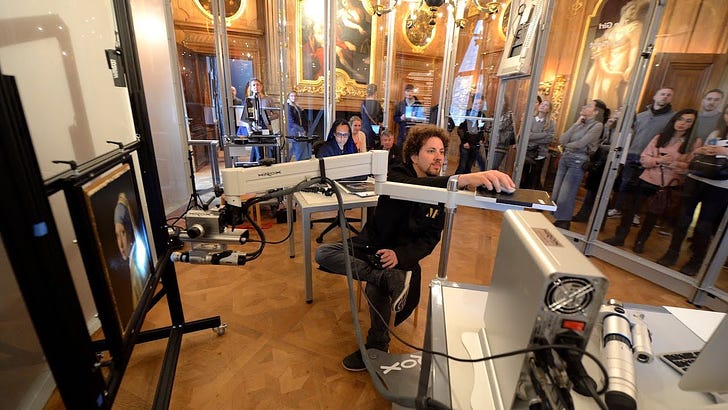Hi everyone,
Headlines, prefixes, technology, and handmade Italian pasta have drawn my attention this week. Language takes us down many roads, each of which plays a role in reactivating, maintaining and growing vocabulary skills all the while enjoying good reads and videos!
Patently Untrue
A patent lie is a plain lie. Patent insincerity denotes a complete lack of sincerity. So you may ask, what’s the connection with patents and intellectual property? Interestingly, it has to do with royal written orders and keeping official information public, out in the open.
“Letters patent” (from the Latin litterae patentes) were public orders written on a letter bearing the monarch’s royal seal. The document would announce the granting of rights or a license of kinds to individuals, families, corporations, etc. Because the seal was added to an open, unfolded letter, there was no need to break it in order to access its content, unlike a folded, closed and sealed letter, whose intended recipient would presumably break the seal to read its confidential content.
A patent is now defined as a “declaration issued by a government agency declaring someone the inventor of a new invention and having the privilege of stopping others from making, using or selling the claimed invention”. The notion of public order remains as government bodies issue patents through patent offices. The information remains accessible and open, protecting the rightsholder(s) who otherwise might find it in their better interest to keep their work under the shroud of secrecy.
A patent lie is an open, public lie. Patent insincerity is visible. Something patently untrue is not true, suggesting there is evidence to prove the lack of truth.
A Quick or a Close Scan?
We can closely scan a landscape, our eyes moving in a careful, linear pattern to look for a bird nest or elusive animal life, or we can place a document into a scanner to make a perfect, digital copy. In contrast, we can quickly scan the bus schedule or the sports page to get important details, such as when the next bus is coming, or who won the latest match. Medical scanners are large, foreboding machines that minutely scan and see deep inside our bodies to detect illness and other medical issues.
When university students scan a text, they read to find specific information and skip over much of the content - it is a time-saving reading strategy. In the field of language teaching, a common reading comprehension task is asking learners to scan a text for specific information, like names, numbers, keywords, even if the student does not understand every word. It is a technique to encourage learners to find meaning whatever their level of English may be.
In all of its forms, scanning entails a linear, structured movement - that of the eyes or the machine - to capture information in an organized way: you find the bird’s nest, you find the date in the text, the machine spots and highlights a tumor and so on.
Digital microscopes are powerful scanners that capture microscopic information with such precision that by stitching up millions of images, they reconstruct the whole.
Girl with a Pearl Earring under the Microscope
Vermeer’s Girl with a Pearl Earring dates to circa 1665 and was donated to The Hague’s Mauritshuis art museum in 1902 by a wealthy benefactor who had bought the painting in 1881 for the equivalent of 24 euros. He had taken the heed of one of the first Dutch historic preservationists who urged him to preserve Dutch heritage by buying this small, little-known portrait. It was carefully restored in 1994, selected as the most beautiful Dutch painting in 2006, and finally in 2018, it was scanned under a 3D, high-resolution, digital microscope.
Historic preservation, or heritage preservation (US) or conservation (UK) seeks to conserve and protect architectural structures, landscapes, objects and other tangible forms of heritage. Cultural and culinary traditions are part of our intangible heritage.
The scan reveals the unseen: The girl in the portrait has eyelashes although I’m not sure I’ve found them; Vermeer used the expensive ultramarine pigment made from Lapis Lazuli exported from Afghanistan; and her lips are colored with cochineal red, a dye made from the cochineal insect found in Latin America. You’ll also find it as E120 in the list of accepted food additives.
The scan uses focus stacking to create a 3D image by taking lots of images of the same surface but using different focal points. If you’ve tried macro photography or even taking pictures of a cat, you’ll know how difficult (impossible) it is to get everything into sharp focus. A petal is half-blurred for an artistic look while the cat’s whiskers perfectly stand out in front of its unfocused eyes. Focus stacking layers (stacks up) perfectly focused shots of the nose, whiskers, hairs, eyes, etc. into one, making one sharp cat. This is what the human eye does, when we focus on one part of an object but still see the rest well.
This imaging technique reveals the painting’s surface, or topography, including dust, clumps of paint and crackles. The result is absolutely stunning and a delight to the eye and I urge you to visit their website.
This same website is also a tool to learn about painting techniques - we can compare light effects, shadows, splotches of color, and lines by changing our viewing distance, from the perspective of a normal museum visit to highly magnified close-ups of abstract surfaces few will ever see in person.
The video in the links explains the scanning process and trains your ear to better understand a French accent.
Are you making this mistake in English?
What’s the difference between flammable and inflammable?
This is a trick question, isn’t it! While correct and incorrect, or justice and injustice are antonyms, or opposites, flammable and inflammable are synonyms meaning (something is) capable of burning. Flammables, or inflammables are nouns and describe liquids, textiles and other materials, chemicals, etc. that (easily) burst into flames.
The prefix “in-” often means negation, much like “un-” in unimportant, or the “il-” in illogical, but there was another “in-” in Latin, meaning “into”. In today’s example, “in-” intensifies what comes next and gives a stronger than “flammable”.
An inflammable liquid or material not only catches on fire, but it easily catches on fire. This notably created havoc in the textile industry several decades back, and I still recall the confusion I felt as a child the first time I read my brand new nightie’s label!
Nighties
There was a time when thin, shimmery polyester-cotton blends were trending nightwear fabrics because they were seen as practical, light and more “breathable” than pure polyester. These blends were also much more flammable, making nightwear highly flammable, or inflammable. During a house fire, a nightgown could burst into flames on the wearer. A strong heat source, such as a fireplace or stove, or even a single spark, from a candle or gas stove, could set off a disaster. This is why the warning label on polyester-cotton blend clothing read, at that time, “Inflammable material.”
You may see where this is going: the word inflammable created much confusion even among native speakers of English who were persuaded that their night apparel, or their children’s nightwear was nonflammable. Manufacturers began adding chemical compounds called flame/fire retardants, to slow down the spread of flames, or to temporarily reduce the degree of inflammability.
I can’t tell you how many times I read nightgown labels as a child before working out the intricacies of these words that sounded like “flame”. First, I was highly impressed that my nightgown couldn’t catch on fire. I argued with my mother - why would anyone believe that flammable and inflammable would mean the same thing?! Why would anyone sleep in something that could burst into flames? And what about fire retardant? If it isn’t woven in, then logically, it washes out like dirt and stains. To tell you the truth, I thought it was kind of disgusting that it wouldn’t wash out, either. Who doesn’t want a clean nightgown? More importantly, how long would a retardant delay flames… None.of.it.made sense!
A Cool Prefix!
But now, I like the leveraging power of this prefix, especially how it pushes the original word’s meaning into excess! Think of valuable and invaluable, estimable and inestimable, where worth is too great to name and calculate? What about the famous and the infamous, where the individual behind the name is remembered with either respect or horror?
Over the years, language was simplified. Industry terminology now favors flammable over inflammable, while international pictograms illustrating properties of hazardous materials and goods provide further clarity. Consumer-friendly labels, such children’s White and Red safety labels in New Zealand read, “Warning: Keep away from heat and flame,” and for inflammability, “Warning: High fire danger. Keep away from heat and flame.” (see links below)
Recipes - Two “Pasta Grannies”
Wholesome, heartwarming and interesting videos abound on the Pasta Grannies YouTube channel, but Feni’s use of lemon juice in her pan-pizza dough intrigued me. I couldn’t not include Letizia Favuzza, a 101-year-old retired teacher who has a Facebook account, writes poetry and still makes handmade pasta.
Pasta Grannies showcases Italian grandmothers who make delicious, traditional, handmade pasta. As the British producer says, she is “saving skills and sharing traditions one recipe and Granny at a time!”
The grannies speak Italian but the interviewer provides explanations in English along with the subtitles, so this is a fine and enjoyable way to step up your reading and listening skills!
We would love to hear about your favorite pasta recipes - do join us Tuesday, February 9th in our free conversation class at 7.30 PM Swiss time (UTC + 1). (see links below)
We know language is passed on through generations, migrations, social activities, music, literature, school, family and more… some words remind you of a beloved mentor or family member, or you find yourself using the latest trending words, not sure they’ll still have meaning down the line. As much as we may have sweated and toiled over native and other language arts at school, we know language is lifelong education.
As cultural treasures and generational educators, adorable “Pasta Grannies” have made it down the line and thankfully, their knowledge has a broader reach through social media. Their knowledge - much to our delight - is literally more nourishing and substantial than words, although it is said that words nourish the soul, and I dare say, if you take the time to enjoy a good read, it’s probably got substance.
Notes and Links
If you enjoy stimulating discussions, check out the English Book Club, a nourishing international experience to grow and maintain your language skills over a good read! If you are concerned about “not being good enough”, don’t be, and remember that the English Toolkit is there to help you with pronunciation and overall skills!
Book Club: https://learn.ohyes.ch/courses/step-up-book-club-january-2021/preview
Free Conversation class: https://www.facebook.com/events/432748068173922/
Patent, Wiktionary: https://en.wiktionary.org/wiki/patent
Girl with a Pearl Earring, 10-Gigapixel interactive scan: https://www.micro-pano.com/pearl/
UNESCO’s World Heritage List: https://whc.unesco.org/en/list/
Intangible heritage: https://en.unesco.org/news/blending-our-past-cultivating-our-future-unesco-world-forum-underscores-culture-food-and
New Zealand product safety standards, children’s nightwear: https://comcom.govt.nz/business/your-obligations-as-a-business/product-safety-standards/childrens-nightwear
Picture of White and Red Labels, NZ children’s nightwear: https://comcom.govt.nz/__data/assets/image/0024/86523/Childrens-nightwear-2-Labels.jpg
Irresistible Pasta Grannies:










